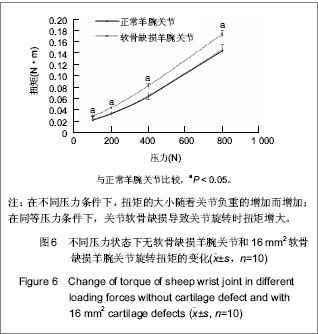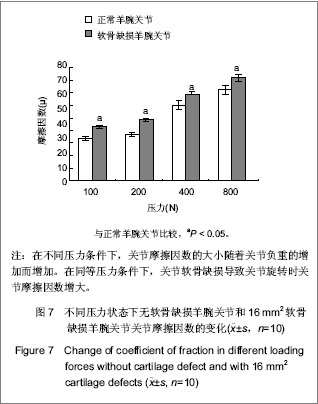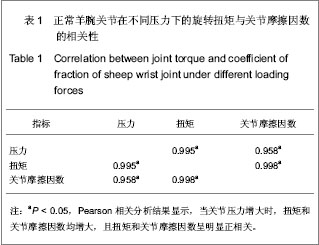| [1] Koonce RC, Bravman JT. Obesity and osteoarthritis: more than just wear and tear. J Am Acad Orthop Surg. 2013;21(3): 161-169.[2] Thomsen J, Straarup T, Danielsen C, et al. No effect of risedronate on articular cartilage damage in the Dunkin Hartley guinea pig model of osteoarthritis. Scand J Rheumatol. In press.[3] Krasnokutsky S, Samuels J, Abramson SB. Osteoarthritis in 2007. Bull NYU Hosp Jt Dis. 2007;65(3):222-228.[4] Hinton R, Moody RL, Davis AW, et al. Osteoarthritis: diagnosis and therapeutic considerations. Am Fam Physician. 2002;65(5):841-848.[5] Hao W, Mu YP. Linchuang Fangshexue Zazhi. 2012;31(11): 1641-1644.郝崴,牟怡平.透明质酸钠对骨性关节炎疗效评价的T_2 mapping方法实验研究[J].临床放射学杂志,2012,31(11): 1641-1644.[6] Hori Y, Kato K. Studies on tribology. Proc Jpn Acad Ser B Phys Biol Sci. 2008;84(8):287-320.[7] Dowson D. Bio-tribology. Faraday Discuss. 2012;156:9-30, 87-103.[8] Taylor RI. Tribology and energy efficiency: from molecules to lubricated contacts to complete machines. Faraday Discuss. 2012;156:361-382, 413-434.[9] Panjwani B, Sinha SK. Tribology and hydrophobicity of a biocompatible GPTMS/PFPE coating on Ti6Al4V surfaces. J Mech Behav Biomed Mater. 2012;15:103-111.[10] Spencer ND. Tribology. Faraday Discuss. 2012;156:435-438.[11] N'guessan HE, Leh A, Cox P, et al. Water tribology on graphene. Nat Commun. 2012;3:1242.[12] Noble P, Lumay G, Coninx M, et al. A pendulum test as a tool to evaluate viscous friction parameters in the equine fetlock joint. Vet J. 2011;188(2):204-209.[13] Pritzker KP, Gay S, Jimenez SA, et al. Osteoarthritis cartilage histopathology: grading and staging. Osteoarthritis Cartilage. 2006;14(1):13-29.[14] Rieker CB. Tribology considerations for hip joint articulations in relation to the "new orthopaedic patient". Hip Int. 2006;16 Suppl 4:12-16.[15] Liu F, Chen Z, Gu Y, et al. Deformation of the Durom acetabular component and its impact on tribology in a cadaveric model--a simulator study. PLoS One. 2012; 7(10):e45786.[16] Teeple E, Fleming BC, Mechrefe AP, et al. Frictional properties of Hartley guinea pig knees with and without proteolytic disruption of the articular surfaces. Osteoarthritis Cartilage. 2007;15(3):309-315.[17] Crisco JJ, Blume J, Teeple E, et al. Assuming exponential decay by incorporating viscous damping improves the prediction of the coefficient of friction in pendulum tests of whole articular joints. Proc Inst Mech Eng H. 2007;221(3):325-333.[18] Jay GD, Torres JR, Rhee DK, et al. Association between friction and wear in diarthrodial joints lacking lubricin. Arthritis Rheum. 2007;56(11):3662-3669.[19] Neu CP, Komvopoulos K, Reddi AH. The interface of functional biotribology and regenerative medicine in synovial joints. Tissue Eng Part B Rev. 2008;14(3):235-247.[20] Baryshev SV, Erck RA, Moore JF, et al. Characterization of surface modifications by white light interferometry: applications in ion sputtering, laser ablation, and tribology experiments. J Vis Exp. 2013;(72):e50260.[21] Fineberg J. Tribology: Diamonds are forever - or are they? Nat Mater. 2011;10(1):3-4. [22] Gotsmann B. Tribology: Sliding on vacuum. Nat Mater. 2011; 10(2):87-88.[23] Nosonovsky M, Bhushan B. Green tribology. Philos Trans A Math Phys Eng Sci. 2010;368(1929):4675-4676.[24] Nosonovsky M, Bhushan B. Green tribology: principles, research areas and challenges. Philos Trans A Math Phys Eng Sci. 2010;368(1929):4677-4694.[25] Kumar D, Daniel J, Biswas SK. Tribology of steel/steel interaction in oil-in-water emulsion; a rationale for lubricity. J Colloid Interface Sci. 2010;345(2):307-315.[26] Ou J, Wang J, Liu S, et al. Tribology study of reduced graphene oxide sheets on silicon substrate synthesized via covalent assembly. Langmuir. 2010;26(20):15830-15836.[27] Gleghorn JP, Jones AR, Flannery CR, et al. Boundary mode lubrication of articular cartilage by recombinant human lubricin. J Orthop Res. 2009;27(6):771-777.[28] Schmidt TA, Gastelum NS, Nguyen QT, et al. Boundary lubrication of articular cartilage: role of synovial fluid constituents. Arthritis Rheum. 2007;56(3):882-891.[29] Eltawil NM, De Bari C, Achan P, et al. A novel in vivo murine model of cartilage regeneration. Age and strain-dependent outcome after joint surface injury. Osteoarthritis Cartilage. 2009;17(6):695-704.[30] Mastbergen SC, Marijnissen AC, Vianen ME, et al. The canine 'groove' model of osteoarthritis is more than simply the expression of surgically applied damage. Osteoarthritis Cartilage. 2006;14(1):39-46.[31] Yuan Q, Kan WB, Song PF, et al. Influence of Bushen Huoxue decoction on beta-catenin, MMP-7 of synoviocytes in rats with knee osteoarthritis. Zhongguo Gu Shang. 2012;25(9): 761-765.[32] Zhang CX, Sun L, Xiu ZB. Effects of pilose antler polypeptide on the glycosaminoglycan and type II collagen in experimental knee osteoarthritis. Zhongguo Gu Shang. 2012;25(2):138-142.[33] Zhang Q, Lv Hh, Chen A, et al. Efficacy of infliximab in a rabbit model of osteoarthritis. Connect Tissue Res. 2012; 53(5): 355-358.[34] Cheng T, Zhang L, Zhao XL, et al. Jiepou Xuebao. 2012;43 (4):540-544.程潭,张柳,赵小林,等.兔实验性骨性关节炎早期软骨下骨板的变化[J].解剖学报,2012,43(4):540-544.[35] Chu M, Sun LS, Jiang Q. Zhongguo Weichuang Waike Zazhi. 2012;12(7):659-663.储淼,孙立胜,蒋青.不同年龄兔前交叉韧带切断后关节软骨变化的研究[J].中国微创外科杂志,2012,12(7):659-663.[36] Yang RF, Hu YY, Wu YS, et al. Zhongguo Jiaoxing Waike Zazhi. 2006;14(19):1497-1499.杨瑞甫,胡蕴玉,吴银松,等.兔骨性关节炎两种动物模型的比较[J].中国矫形外科杂志,2006,14(19):1497-1499.[37] Intema F, DeGroot J, Elshof B, et al. The canine bilateral groove model of osteoarthritis. J Orthop Res. 2008;26(11): 1471-1477.[38] Intema F, Sniekers YH, Weinans H, et al. Similarities and discrepancies in subchondral bone structure in two differently induced canine models of osteoarthritis. J Bone Miner Res. 2010;25(7):1650-1657.[39] Mastbergen SC, Marijnissen AC, Vianen ME, et al. Inhibition of COX-2 by celecoxib in the canine groove model of osteoarthritis. Rheumatology (Oxford). 2006;45(4):405-413.[40] Lorenz A, Rothstock S, Bobrowitsch E, et al. Cartilage surface characterization by frictional dissipated energy during axially loaded knee flexion-An in vitro sheep model. J Biomech. 2013; 46(8):1427-1432.[41] Shen W, Chen J, Zhu T, et al. Osteoarthritis Prevention Through Meniscal Regeneration Induced by Intra-Articular Injection of Meniscus Stem Cells. Stem Cells Dev. In press.[42] Kerschan-Schindl K. Osteoarthritis. Wien Med Wochenschr. In press. [43] Stemberger R, Kerschan-Schindl K. Osteoarthritis: physical medicine and rehabilitation-nonpharmacological management. Wien Med Wochenschr. In press.[44] Ghosh S, Bowen J, Jiang K, et al. Investigation of techniques for the measurement of articular cartilage surface roughness. Micron. 2013;44:179-184.[45] Drewniak EI, Jay GD, Fleming BC, et al. Comparison of two methods for calculating the frictional properties of articular cartilage using a simple pendulum and intact mouse knee joints. J Biomech. 2009;42(12):1996-1999.[46] Teeple E, Elsaid KA, Fleming BC, et al. Coefficients of friction, lubricin, and cartilage damage in the anterior cruciate ligament-deficient guinea pig knee. J Orthop Res. 2008;26(2): 231-237.[47] D'Lima DD, Hashimoto S, Chen PC, et al. Cartilage injury induces chondrocyte apoptosis. J Bone Joint Surg Am. 2001; 83-A Suppl 2(Pt 1):19-21.[48] Ravanbod R, Torkaman G, Esteki A. Biotribological and biomechanical changes after experimental haemarthrosis in the rabbit knee. Haemophilia. 2011;17(1):124-133.[49] Stanton RE. The selective absorption of potassium by animal cells : iii. the effect of hydrogen ion concentration upon the retention of potassium. J Gen Physiol. 1923;5(4):461-468.[50] Nosonovsky M. Self-organization at the frictional interface for green tribology. Philos Trans A Math Phys Eng Sci. 2010;368 (1929):4755-4774.[51] Katta J, Jin Z, Ingham E, et al. Biotribology of articular cartilage--a review of the recent advances. Med Eng Phys. 2008;30(10):1349-1363.[52] Garstang SV, Stitik TP. Osteoarthritis: epidemiology, risk factors, and pathophysiology. Am J Phys Med Rehabil. 2006; 85(11 Suppl):S2-14. |



.jpg)
.jpg)
.jpg)
.jpg)